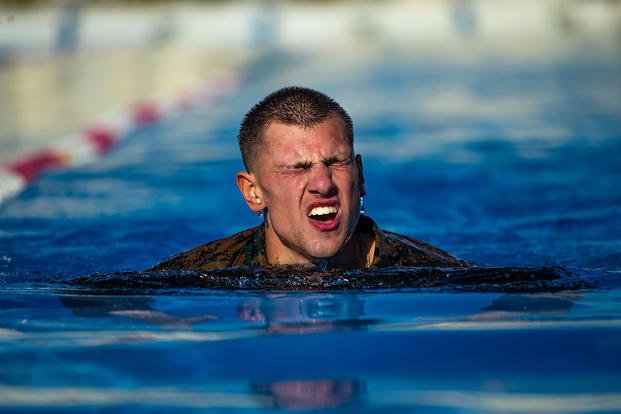When you’re undergoing military training for rescue swimming or scuba diving, you are definitely going to face challenging pool evolutions. You will need to improve your conditioning for the endless swimming, treading, drownproofing, breath holds, and tactical applications of combat diving.
Daily swim workouts will improve your water confidence abilities. Try this unique combination we created for special ops candidates this week.
Swimming conditioning is harder than cardio activities on land. Even the best runners of the group must work to get into swimming shape. The better the technique with the swim strokes, the less effort needed for each lap of a several mile swim or a short-and fast-swim test (Navy Physical Screening Test or the Air Force Initial Fitness Test/Operator Fitness Test). The 50-50 Workout is excellent training that improves swim conditioning and the technique for both the freestyle and combat swimmer stroke (CSS).
Treading is a killer for people who are negatively buoyant, so they will have to practice the technique while simultaneously getting into treading shape if they want to excel in these basic water confidence tests.
Most people dismiss treading and do not realize that treading is vertical swimming, especially if you are not allowed to use your hands, which is a requirement in many of the swim and dive training treading tests. Learn these treading techniques and apply them to your swim practice each day either as a warmup or cooldown.
Drownproofing in the military takes two forms. One is the basic drownproofing where you ditch your gear and learn to use your uniform to make flotation devices to survive an overboard situation.
The second is the special ops level drownproofing where you have your hands tied behind your back, your feet tied together and you must perform a series of drills for about 30 minutes. The events include bobbing in a 9-foot pool, floating, swimming 100 meters, doing a front flip and back flop off the bottom of the pool, and picking up your mask with your teeth at the bottom of the pool.
Taking all the above into consideration, here is how to combine multiple events and swim workouts to help you with many of the challenges you will face in these military training programs. This is basically a mix of the 50-50 with the drownproofing and treading workout.
Tread: 5 minutes with no hands to warm up
Swim: 50 meters freestyle fast and 50 meters CSS (rest 15 seconds with treading)
Bob: 2 minutes. Pretend your hands are tied behind your back and put your feet together
Swim: 50 meters freestyle fast and 50 meters CSS (rest 15 seconds with treading)
Float: 2 minutes. Pretend your hands are tied behind your back and put your feet together
Swim: 50 meters freestyle fast and 50 meters CSS (rest 15 seconds with treading)
Travel: 100 meters. Pretend your hands are tied behind your back and put your feet together. (Rest with 1 minute bobbing)
Front Flip: Pretend your hands are tied behind your back and put your feet together
Swim: 50 meters freestyle fast and 50 meters CSS (rest 15 seconds with treading)
Back Flip: Pretend your hands are tied behind your back and put your feet together
Swim: 50 meters freestyle fast and 50 meters CSS (rest 15 seconds with treading)
Pick up mask with teeth from bottom of pool. Pretend your hands are tied behind your back and put your feet together
Tread: 5 minutes with no hands to cool down.
After this section of the workout, complete a total of 10 sets of the 50-50 Workout by doing 5 more sets with a 15-second tread as your rest each set. This will create a workout with more than 1,000 meters of tough swimming combined with just about all the pool skills you need to safely practice water confidence events.
If you are trying to improve your swim conditioning, 1,000- to 1,500-meter swim workouts will help you prepare for a 500-meter or 500-yard swim test. Put in the time with 4-5 days a week of swimming and, at the end of a month, you will see a huge difference in your swimming abilities and conditioning.
Do not swim alone. Do not tie yourself and swim. This is a simulated drownproofing event. If you practice underwater swimming technique, do not swim alone or without a lifeguard present. Do not try to push your ability to hold your breath underwater. The key to underwater swimming is technique and efficient swimming.
Stew Smith is a former Navy SEAL and fitness author certified as a Strength and Conditioning Specialist (CSCS) with the National Strength and Conditioning Association. Visit his Fitness eBook store if you're looking to start a workout program to create a healthy lifestyle. Send your fitness questions to stew@stewsmith.com.
Want to Learn More About Military Life?
Whether you're thinking of joining the military, looking for fitness and basic training tips, or keeping up with military life and benefits, Military.com has you covered. Subscribe to Military.com to have military news, updates and resources delivered directly to your inbox.


















